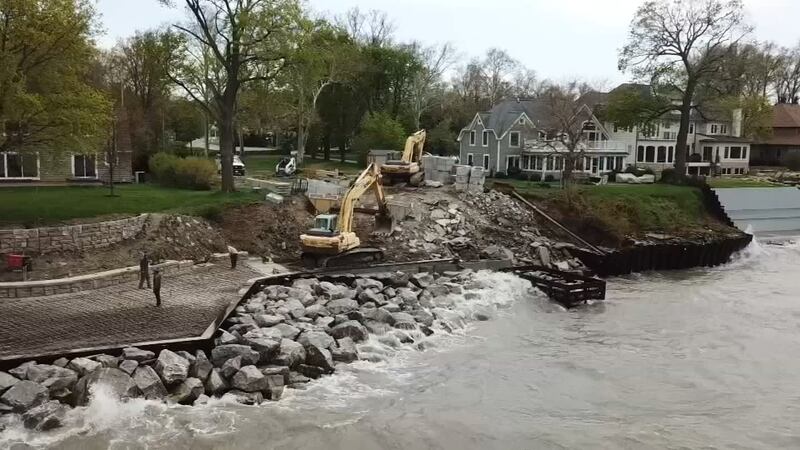ERIE, Pa. — ERIE, Pa. (AP) —Carp are swimming in a flooded picnic area at Presque Isle State Park.
Docks have become so submerged along Presque Isle Bay that the Erie-Western Pennsylvania Port Authority has placed concrete blocks atop some of them to warn boaters.
And at Ferncliff, the tiny neighborhood of picturesque houses that sit along the bay just east of the Erie Yacht Club, waves are covering the front sidewalks and lapping against the front stoops.
"It goes up and down," said Gib Loesel, a Ferncliff resident for 30 years. "It is kind of like a tide."
That tidelike motion is continuing to flow in, changing the landscape along the shoreline in Erie County in ways not seen since the mid-1980s, when the water levels of Lake Erie and the other Great Lakes were last at such high levels.
Lots of changes on PI this summer due to this. https://t.co/HnaEdOhSrT
— Presque Isle (@PresqueIsleSP) June 5, 2019
Especially around Presque Isle Bay, Erie has turned into even more of a watery world as Lake Erie and the other Great Lakes hit record levels due to the extremely wet winter and wet spring.
As of Friday, Lake Erie was at 574.54 feet above sea level, which is a half a foot above the previous May record, from 1986, according to the Army Corps of Engineers, whose Great Lakes statistics date to 1918 and are based on data collected from a gauge network.
All the Great Lakes "are currently above their record highs for the month of May, with Erie the highest above its record by 6 inches," according to the Army Corps.
Lake Erie is 6 inches higher than it was a month ago and 9 inches higher than it was a year ago.
'Just absolutely crazy'
By the numbers
As of Friday, Lake Erie was at 574.54 feet above sea level, according to the Army Corp of Engineers.
That is, according to the Army Corps:
- 6 inches higher than the previous record for May, set in 1986.
- 6 inches higher than the lake level on May 1.
- 9 inches higher than the lake level on May 31, 2018.
- 2 feet and 8 inches above the long-term monthly average for May, which is 571.88 feet.
- 3 feet and 2 inches above the long-term annual average, which is 571.36 feet.
The water keeps rising
"I've had water in the office building here," said Erie bayfront stalwart Tim Sedney, whose ventures include the original Rum Runners on East Dobbins Landing and his new office building nearby in the former Lund Boat Works.
About 2 feet of water recently filled the office building, Sedney said. The high water has also affected how he handles his tour boats, including the Scallywags pirate ship docked on West Dobbins Landing, just south of his Rum Runners Cove in the Sheraton complex.
When water levels were lower, most boarding ramps went down, Sedney said. Now they go up.
"It is crazy, just absolutely crazy," he said.
And, in some cases, dangerous.
TRENDING NOW:
- Police searching for man following 'suspicious' fires
- Company to pay $1K for someone to use flip phone for a week
- Emergency closure: Part of Ross Township road restricted to one lane
- VIDEO: ‘I am proud to hunt': Hunter Defended Killing Giraffe in 2017
- DOWNLOAD the Channel 11 News app for breaking news alerts
At the Chestnut Street Boat Launch, off the Bayfront Parkway, boaters travel between two long docks to leave the marina and reach the open waters of Presque Isle Bay. But the docks are underwater, creating the risk that boaters could drive over them, ruining their watercraft.
To ease the problem, the Erie-Western Pennsylvania Port Authority on May 22 marked the docks by placing large concrete blocks and posts at the ends of them.
"We were concerned that boaters would not realize there is a dock there," said the Port Authority's executive director, Brenda Sandberg.
She said high water "is a story all across the bayfront," but that Erie has experienced less disruption than Lake Erie towns in Ohio and towns in New York, where Lake Ontario has swamped harbors and lakeshore homes. Of all the Great Lakes, Lake Ontario has risen the most — 18 inches in the past month and 2 feet over the past year, according to the Army Corps.
"We have been lucky," Sandberg said.
Even with the Port Authority's improvements along the bayfront, boaters must be careful, said Mark Rose, an Erie-based charter boat captain who regularly uses the Chestnut Street Boat Launch. He said navigating the launch's marina still can be difficult, especially for boaters unfamiliar with Presque Isle Bay.
"You got to hit that hole exactly correct or you're going to be right up on that concrete," Rose said. Of the high water levels, he said, "It is really bizarre. You just got to do things differently. But the fish are still there. You just need to watch what you are doing."
Though the high water levels can look strange — from certain angles on Dobbins Landing, Presque Isle Bay resembles an overflowing bathtub — the rise in Lake Erie and the other Great Lakes is expected, said Donald Wuebbles, a University of Illinois atmospheric science professor who led the writing of a report, released in March, on the impact of climate change on the Great Lakes region.
The report predicts wetter winters and springs, leading to higher lake levels. The amount of precipitation in the upper Great Lakes — Superior, Michigan and Huron — influences the level of Lake Erie.
Whether the high lake levels will persist is uncertain, Wuebbles said in an interview.
"We don't really know," he said. "I think it is a possibility, because more precipitation is coming."
At the same time, Wuebbles said, warmer temperatures due to climate change "could lead to more evaporation. It depends on how all that balances out. We still need to do a more definitive study on this."
Joseph Griesbaum is more certain of what will happen. On Thursday, while the Springfield Township resident was fishing on the North Pier at Presque Isle State Park, he mused that the water levels would return to their more regular levels eventually.
"It will fluctuate," Griesbaum said. "God has a plan for it. It will work out."
Watching the waves
The Army Corps is predicting that the Lake Erie will drop by 2 inches by July 1.
A drop of that magnitude might be enough for the water to recede throughout Presque Isle State Park, where carp are frolicking in a swamped picnic area near the lagoons and the pontoon-boat tour site. The drop might also help residents of the park's Horseshoe Pond houseboats, who have built a gravel footpath to get past the high water at to the docks to get to their floating homes.
Closer to Erie, a 2-inch drop might also mean less water in front of the house of Gib Loesel and his fellow residents of Ferncliff.
Loesel, 80, said he remembers high water from years ago, but said the waves have never flowed into his house. It is built along the western edge of the neighborhood, next to a paved parking lot. Being closer to the land has helped keep his place dry, Loesel said.
"I am able to get out of here mostly without putting my boots on," he said.
And what if Lake Erie and Presque Isle Bay rise enough to threaten his house?
"If it gets that high," Loesel said, "I am moving."
Associated Press







